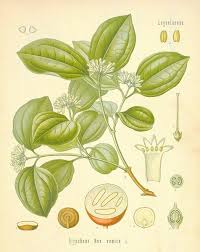DESCRIPTION
Strychnine is an alkaloid extract by Strychnos nux vomica, also known as Nux vomica, a deciduous tree native to southeast Asia, a member of family Loganiaceae.

It’s a white powder from the slightly bitter taste ant it was discovered by the French chemists Joseph-Bienaimé Caventou and Pierre-Joseph Pelletier in 1818 in Saint-Ignatius'-beans (S. ignatii), a woody vine of the Philippines.
It has a molecular formula of C21H22N2O2. It is practically insoluble in water and is soluble only with difficulty in alcohol and other common organic solvents.

See technical card of pesticides database.
INDICATIONS
Therapeutically, doses of 1–3 mg are used, causing an increase in spinal reflex. At this dose, the tension of the striated muscle is raised, but there is practically no effect on respiratory and circulation.
In the past strychnine was used in therapy, but because of its high toxicity and tendency to cause convulsions, the use of strychnine in medicine was eventually abandoned once safer alternatives became available.
Use in the past.
At doses of 5–10 mg, the spinal reflex increases considerably and the muscles are tautened up to painful immobility.
Higher doses cause anxiety, dyspnoea, tonic convulsions, which lead (because of an excessive and continuous muscle activity) to hyperthermia, acidosis and rhabdomyolysis and finally to complete muscle paralysis. All voluntary muscles are in full contraction, flexor and extensor are simultaneously maximally contracted. The convulsions are extremely painful because of the rupture of tendons and joint capsules. The whole body is arched backwards in hyperextension and is only supported by head and heels (this posture being called opisthotonos). The patient usually retains consciousness between convulsions, but if anoxia supervenes, coma may follow repeated convulsions. Chest muscle and diaphragm spasms result in hypoxia and respiratory failure, when hypoxia and cardiac spasm result in cardiac insufficiency and cardiac arrest.
Strychnine effects.
MOLECULAR MECHANISM
Strychnine acts as powerful stimulating of the central nervous system. It blocks the inhibitory or strychnine-sensitive glicine receptor. When glycine receptors are activated, chloride enters the neuron via ionotropic receptors, causing an Inhibitory postsynaptic potential (IPSP). Strychnine is a strong antagonist at ionotropic glycine receptors. Death is usually due to asphyxiation resulting from continuous spasms of the respiratory muscles.
GlyR
METABOLISM
Strychnine is absorbed very rapidly through the gastrointestinal tract, the respiratory tract and intact skin. In addition, it is well absorbed when given via the parenteral route (subcutaneous or intranasal). This alkaloid is very lipophilic and is thus rapidly distributed throughout the body.
The first symptoms usually appear within 5 minutes to 1 hour after exposure, depending on the dose, the route of exposure, and the general medical health of the person exposed. It undergoes rapid and extensive metabolism by hepatic cytochrome P-450 2B and it does not seem to have an accumulative effect.
Five metabolites formed in vitro by rabbit liver were isolated and purified. Three of them were identified as 2-hydroxystrychnine, strychnine N-oxide, and 21-α,22-β-dihydroxy-22-hydrostrychnine, when compared to authentic samples by means of ultraviolet, nuclear magnetic resonance and mass spectrometries. Additionally, two other metabolites were tentatively identified as strychnine by spectral measurements: 21,22-epoxide and 11,12-dehydrostrychnine.
Strychnine N-oxide was the major metabolite and accounted for approximately 15% of the metabolized strychnine. All other metabolites accounted for < 1%. The combination of detoxification and excretion renders strychnine a biological half-life (in humans) of 10–12 hours. Up to 20% is excreted unchanged in the urine within 24 hours.
TOXICITY
It’s one of the more toxic substances that are known.
The acute oral LD50 in two studies of rats treated with strychnine alkaloid is 2.2 and 5.8 mg/kg in females, and 6.4 and 14 mg/kg in males.
Acute dermal toxicity: The acute dermal LD50 in one study was greater than 2,000 mg/kg in albino rabbits. Dermal irritation was minimal with absent or transient erythema. In white mice, dry powder was not absorbed through the skin, but the mice died after dermal application of 1:200 to 1:1,000 concentrations of strychnine in mixtures of alcohol and essential oils, eugenol or anethole which aid skin penetration.
The lethal dose for human adults ranges between 30 and 120 mg, although death of an adult has been reported after an ingestion of 16 mg. The lethal dose for children is about 15 mg. Though strychnine is lethal to humans, early aggressive treatment can be life saving, even following exposure to large doses as high as 3750 mg. In view of the rise in global terrorism, it is important to recognize that strychnine may be utilized by terrorists to induce mass poisoning in urban populations by contamination of major food and water supplies.